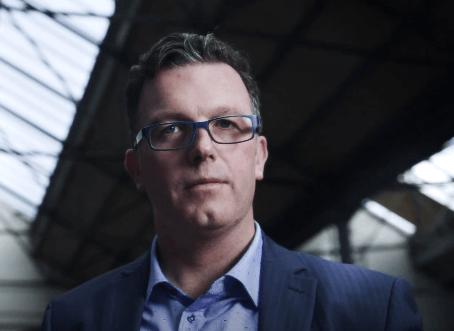
David L. Rogers, a recognized digital transformation expert and the author of ‘The Digital Transformation Playbook’ argues that “pre-digital-era companies can reinvigorate their game plans and capture the new opportunities of the digital world”. However, “studies suggest upwards of 60% of organizational transformations fail”, according to an influential paper “Why Transformations Fail”, co-authored by Ian Duncan, Senior Managing Director and Digital Transformation Leader at FTI Consulting.
Ian has an extensive experience in restructuring large-scale business transformation programs for medium to large enterprises. He intimately knows how to bring such programs back on track and how to handle things from a change management perspective.
“Some people resist change because they don’t know where they belong as an outcome of that change. They become resistant and start to block things. And, it’s the job of the CEO and the leadership team to bring that clarity to their people”, explains Ian.
When asked about the impact these failed transformation programs have on the organization or the sponsors, Ian did not mince words.
“The costs of failure can be enormous – with around one-third of money invested in transformations wasted", Ian Duncan.
In an exclusive interview, Ian shares why transformation programs fail, how to spot ‘people road blocks’ that throttle successful transformations, and the untold truth about large scale transformation programs.
As a specialist in digital, operational and business transformation and integration with over 27 years of industry experience, Ian has advised boards and their executives on strategy implementation focusing on business model optimization and redesigning organizations for growth. A management consultant at heart, Ian enjoys working across different industries, teams, and working styles. The challenge of transforming processes at an institutional level and seeing the fruits of that effort is what keeps him excited. Let’s dive in.

A Changemaker across Industries
“In highly regulated industries like banking and insurance, you've got a lot of top-down management and the decision making is centralized. Driving change requires a lot more personal touch and an understanding of the machinery and mechanics of the institution. It can become very slow and difficult to drive change in large regulated industries. However, if you move into non-bureaucratic structures and industries, it is very easy to execute a more entrepreneurial driven change but can be a little bit chaotic,” says Ian.
Rather than talking about his personal achievements, Ian humbly mentions the people who have inspired him to constantly learn and adjust under new circumstances in each transformation program.
Taking Inspiration from Clients
“I was fortunate enough to work a few years ago with CEO of a services business. His style and way of working was what we may call a servant leadership style. He was very accessible to all his people with an ability to walk into a room and people would gravitate towards him, but he was a very deep listener. He was able to get to the nub of a problem and help his team solve it, but did not necessarily enforce his opinion”.
Ian shares that a great advantage of having an organization-wide purpose and an inspirational leader to help accomplish that purpose keeps transformation programs on track.
Purpose Triumphs Job Description
“I did the whole transformation of the business at one of his UK divisions and across the European network. All his people would put in a lot of discretionary effort. They wanted to be there. They saw purpose in the organization and they connected with the CEO. And they wanted to be successful and they wanted the organization to be successful”.
For leaders to implement and sustain transformation programs, Ian emphasizes the importance of thinking in terms of outcomes. “You assemble your team so people realize what is it they need to do, and you might have it in a job description, or you may not have a functional description of it, but the conversations should revolve around getting to the outcomes in those discussions.”
“I was working with a nonprofit CEO and he came into that business when it was in the middle of transformation. He gave the organization a sense of renewed purpose, because transformations start off with high energy and the there's a dip followed by low performance. People get incredibly anxious when they're deciding where do they fit in the future of the organization? In the moment when people start to think about that, the organization risks grinding to a halt because people become protection driven”.
His advice for leaders is to keep enthusiasm high during transformation efforts while keeping an eye on the outcomes. “The CEO I’m talking about had that ability to be continuously upbeat and to line his people to the right outcomes and drive their energy into the program, hold it, and put in place cadence around that,” says Ian.
But he rightly points out the importance of understanding the pulse of your organizational environment.
“We’re working in an environment where people want more autonomy. They want do interesting work. And it's being able to nurture that enthusiasm, but also give them interesting things to do”. “The role of the CEO and the management team is to figure out that stuff. It’s not possible without staying grounded to the grassroots vibes of the business right through to the senior executive floor. And I think that's a challenge for a lot of CEOs, but those that do manage it are the ones that are the most effective”.
Identifying ‘People Road Blocks’ in Transformation Programs
While others might point towards systems and technologies that can help boards and CEOs to manage large transformation programs, Ian has an advice to look out for people and culture issues more than anything else.
“When we look at people road blocks, we break it into a simple analogy which is the Net Promotor view of the world. We’ve got advocates, neutrals, and detractors and you manage stakeholders from that perspective”. “Your job is to look at the detractors and understand why are they behaving the way they're behaving? What are their beliefs, what are their concerns? And you can remove some of that purely by mapping out what their future is like in the organization. Getting the right discussions from their line management down to those individuals that will get rid of a lot of their concerns, but it won't get rid of all of them”.
For edge cases, Ian has an advice. “For those who are simply unmovable, it is important to make tough decisions and determine if their future doesn’t belong in the organization and to help them realize that and give them alternate options”.
Of course, transformation programs take place in a complex environment where external stakeholders too have an impact on the outcome of the project. Competing interests often negatively impact the success of these programs. Part of Ian’s job is to manage these crucial relationships.
Client-Vendor Relationships: Setting Up the Game the Right Way
“It's no different to setting up the game the right way. There are certain relationships with businesses that are set up to be competitively driven and they can drive the wrong sets of motivations on both sides of the table, which causes problems in the ability to get work done. As an organization everybody needs to win in a transaction or a deal”.
“Not every organization that I've worked with has that framework or that mindset of how they want to deal. They want to drive the best deal they can get, and they want to try and squeeze margin out of the transaction and actually drive what they would perceive as a good deal for the corporate, or for the buying organization. People are realizing that it’s not the best model of doing business”.
"In construction, an industry that has been slow to drive productivity change compared to others, there was an acknowledgement that the approach to manage these relationships has to change. The collaboration is critically important at an expert level, but for people that are spending vast millions of euros on hiring the consulting services or design services there's an acknowledgement that the game needs to change on both sides of the table”.
To drive that change, Ian advises to ditch complex frameworks in favor of simple ones.
A Meta Framework to Setup a Transformation Program
“Setting a transformation program the right way is critical”, advises Ian. “One of the frameworks that I have been trained on and deeply value is known as “Commitment-based Management™.
“It starts conversations as a set of potential commitments and goes through a certain structure. And if it lands well, it lands with a commitment where two people agree to share the outcome”. It then leads to action items based on the commitment made between two individuals. It’s a simple view of the world but very effective. Most organizations quickly drop into the detail too quick. And the whole effort of the transformation team becomes about managing, managing the activity or aspects of the detail, but not necessarily going back to the heart of it, which is what are we promising to do together”.
“Some organizations are designed in a way to actually avoid the ability to reach that simple agreement, that simple outcome that you're driving”. When asked about the effectiveness of this simple framework, Ian’s insight ran counter to the popular advice about not taking things personally. “There is a sense of personal skin in the game when you make a commitment, which brings with it a discretionary effort and a sense of going the extra mile to make it happen. Your identity is attached to it which makes it really important. If you can get an organization and a group of people to have more personal skin in the game, your probability of success increases exponentially”.
Despite best intentions and adequate resources, programs still fail and Ian has helped implement the recovery processes for some of these programs in Ireland.
Why Transformation Programs Fail?
“I was fortunate enough to lead the recovery process of a couple of large-scale transformations where the typical work involves understanding why it's landed them at the place that it has got to. We do our discovery and diagnosis and we interview people that are not just the ones that are the cheerleader of the project to put it out in front of you, but we like to go deeper. We interview a lot of people that may not be the client's preference for you to see because there are some ugly things that happen when you get down to people in the organizations who feel a lot more pain and are probably a lot rawer at the edges of the challenge. So what we discovered was that it's never about the technology”.
“It's nearly always not about the process not being well enough, although there are some issues about execution and implementation, but it generally is down to individuals and people”. Ian is quick to point the nuances of language that might play out when you try to assess a derailed transformation program.
Same Language, Different Meanings
“A number of years ago, I was working in a project where I had to look at a core system implemented in a utility company. The problem was dressed up by saying that the SI (System Integrator) is not performing well. That was the way it was presented. We did our diagnosis and analysis of that problem”.
Upon closer look, Ian’s team found that the problem was not at the SI’s end. “A careful listening approach directed towards all project stakeholders revealed that they were using same words/language to explain different things”.
“When I talked to customer service team that was looking to accept the project, they kept saying this is a business sponsored program and we're responsible for successfully adopting it and we're going to make it happen. However, when I spoke to the corporate IT of the organization, folks who were supporting the SI, they were saying the same thing that this is a business orientated project and they are responsible for ensuring it's a success. Though it seemed like a surface-level alignment between all teams, in reality, both IT and SI was saying that the business guys don’t have a clue, but it's not our problem”.
“So there was a real disconnect and the language they use is the same language. And it could have been interpreted at a very surface level, in that they're aligned, but alignment is critically important. There was a misalignment there between the two communities and it was a mess and the project needed to go through a restructuring”.
“This program was two years in delivery at this point and a lot of those beliefs and behaviors were embedded in the people that worked at either side of that transformation. We had to address that to get the program on track again”.
Citizen Development Canvas by PMI
One of the key projects Ian Duncan was involved in was the ‘Citizen Development Canvas’ launched by the Project Management Institute’ (PMI). The PMI Citizen Development Canvas is a definitive map for organizations looking to adopt and scale citizen development.
“I've been fortunate enough to have worked with PMI for two years as a strategic advisor. We did a number of big programs and one was the citizen development canvas. It was a fantastic piece of work where we explored on their behalf, whether there was a marketplace for building a diagnostic framework to help organizations adopt and scale Citizen Development for business”.
Ian took his experience in setting up Citizen Development-led transformation programs to the construction industry as he worked with PMI to address the chronic problem of resource wastage in mega construction projects.
Can Construction Industry Benefit from Citizen Development?
“The other program that we worked with PMI regarding Citizen Development was in the construction industry. The industry suffers a lot of pain points in productivity, has an average of 5% net margin, and is a highly competitive industry. PMI was servicing a lot of their needs for the PMP program and offering training to help project managers understand how to manage programs better. PMI acknowledged, based on an analysis that we did and some study of the industry, that there was a bigger game to play here about helping the construction industry drive better outcomes in projects by becoming deeply involved in what happens inside these large mega construction projects. W we worked with PMI and brought partners to the table including CII (Construction Industry Institute) as part of the expert panel.”
“We also brought in the Lean construction Institute as well and we spent time with experts over a period of 12 months understanding how we drive programs of change and documented that into a set of training programs for the construction industry”, says Ian.
Digital Office in Construction
Ian has seen an increasing interest in ‘Digital Office’ in the construction-related firms.
“We talked to one of the big general contractors in construction and they're investing a lot in the Digital Office. The challenge with construction when it comes to drive efficiency into a large construction program is that there are a lot of coordination steps and missteps that create waste”.
“That waste manifests itself in product supply chain and goods arriving late or manufacturing of those goods as well, and thus upfront planning becomes critical. It also manifests itself onsite through simple coordination mishaps. Therefore, getting technology to solve that problem is an interesting development in construction.”
Ian points out other problem areas as well in construction, and how digitalization can address them.
“There are a lot of people involved in construction. It's very manual intensive industry. I think it's 13% of GDP globally is produced through construction industry and it is a huge employer around the world. Solving that problem around productivity and driving efficiency into a project requires the organizations to work through technologies that will help. Installing that system through the Digital Office as this is a reasonably new development, but it also takes a commitment from the owners who are writing the checks for these large programs, and their partners like the design consultancies and the general contractors all need to reach a different way of working to enable success”.
Asked about the underlying realities and untold truths about large-scale transformation programs, Ian was candid in sharing what he has seen playing out.
Untold Truths about Transformation Programs
“Historically what has happened is that the capital invested into transformation happens sometimes without doing the proper due diligence. And then there are a lot of personalities attached to that decision. It’s hard for the program sponsors to reexamine and realize that perhaps the program was setup on the wrong premise or it’s not going to deliver on its financial benefits. It is painful for the sponsors or the team to seem to be failing”.
“It’s also a mindset and an organizational cultural concern as they soldier on regardless and they do window dressing. There's so much money wasted on that playout in transformation programs that needs to be addressed. That’s the reality of large-scale transformation programs as people's identity gets attached to a it and when it starts to get into trouble, and a lot of them do, everyone feels stuck, So, instead of window dressing, we try to start addressing the real issues with the program”.
“Some of that means that you need to have a culture of trust where you say, hey, I'm making mistakes here and its okay, and I’m not getting fired for being honest.” Despite being a staunch supporter of getting the CEO to commit to a transformation program, Ian did not miss out on the importance of getting your operational teams to mobilize behind the plan and that’s where he see the true potential of Low-Code/No-Code technologies.
Subject Matter Experts Benefit from Low-Code/No-Code
“Getting the CEO's commitment is really important to set the game the right way and for frontline teams to stay committed and be reasonably hands-on. But the reality is you've also got to mobilize the operational teams and the frontline teams. And one of the things that excite me about, Low-Code/No-Code is that it is giving those subject matter experts the ability to automate a business process or to change a customer experience. And, that’s a reasonably new as a technology”.
This article is a lightly-edited summary of Ian Duncan’s appearance on our 'Demystifying Enterprise Innovation' Podcast, “Why Transformations Fail?” If you haven’t listened to our show yet, be sure to check it out here.
Are you ready to reengineer your business
automation processes?

A modern process automation and orchestration platform that enables you to open up and seize new business opportunities, supercharge innovation, unlock new levels of efficiency and productivity, and deliver the experiences that help you win.
Follow Us
Platform

Automate business processes and workflows at scale. AgilePoint helps enterprises democratize and accelerate digital transformation, reduce technical debt and future-proof ROI.
Resources
© 2023 AgilePoint. All rights reserved.



